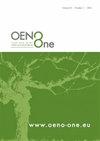An investigation of vine water status as a major factor in the quality of Merlot wine produced in terraced and non-terraced vineyards in the Vipava Valley, Slovenia
IF 2.2
3区 农林科学
Q3 FOOD SCIENCE & TECHNOLOGY
引用次数: 0
Abstract
Terraced vineyards are cultural landscapes with a special value. The increase in costs and the lack of professional workers make viticulture on terraces difficult to be maintained. Thus, in the face of climate change and production challenges, we aimed to study the impact of slope-wise cultivation on wine quality. The quality of Merlot wines from terraced and slightly lower non-terraced vineyards within a small area characterised by similar mesoclimatic features was compared in the seasons 2019 and 2020. The non-terraced and terraced vineyards differed in both soil profile and morphology. The number of buds, number of clusters, and leaf area were standardised, and the stem water potential (SWP) was measured during wine-growing seasons. Upon reaching maturity, grapes were hand-picked on the same day in all vineyards and microvinified. The wines were analysed chemically and sensorially. In both years, the SWP showed higher water stress in the vines from terraces. The yield, berry weight, and leaf area were lower on terraced than on non-terraced vineyards in both years, and the skin- and seed-to-flesh ratios were higher. The darker seed colour pointed to the advanced ripening on terraces, where the wines had a higher alcohol concentration and a higher total dry extract. The wines from terraces had higher concentrations of total polyphenols, anthocyanins, and proanthocyanidins (PAs) than the wines from non-terraced vineyards in both years, and the PAs in the wines from terraces in 2019 had fewer prodelphinidins and were more galloylated. Higher concentrations of higher alcohols and lower concentrations of esters and methoxypyrazines were found in the wines from terraces. The sensory analysis revealed a preference for wines from terraces with better colour intensity, fruitiness, astringency, midpalate, and overall quality. Under experimental conditions (the same harvest date, standardised viticultural variables), the wines from terraces had both better phenolic potential and better sensory quality than the wines from non-terraced vineyards.葡萄藤水分状况是影响斯洛文尼亚维帕瓦山谷梯田和非梯田葡萄园生产的梅洛葡萄酒质量的主要因素
梯田葡萄园是具有特殊价值的文化景观。成本的增加和专业工人的缺乏使梯田上的葡萄栽培难以维持。因此,面对气候变化和生产挑战,我们旨在研究斜坡栽培对葡萄酒质量的影响。在2019年和2020年两个季节,对以类似中气候特征为特征的小区域内的梯田葡萄园和稍低的非梯田葡萄园的梅洛葡萄酒的质量进行了比较。非梯田葡萄园和梯田葡萄园在土壤剖面和形态上都有所不同。对芽的数量、簇的数量和叶面积进行标准化,并在葡萄酒生长季节测量茎水势(SWP)。成熟后,所有葡萄园都在同一天手工采摘葡萄并进行微发酵。对葡萄酒进行了化学和感官分析。在这两年中,SWP在梯田葡萄藤中表现出更高的水分胁迫。在这两年中,梯田葡萄园的产量、浆果重量和叶面积都低于非梯田葡萄园,果皮和种子与果肉的比例更高。较深的种子颜色表明在梯田上成熟较晚,那里的葡萄酒酒精浓度更高,总干提取物也更高。在这两年中,来自梯田的葡萄酒的总多酚、花青素和原花青素(PA)浓度都高于来自非梯田葡萄园的葡萄酒,2019年来自梯田的酒中的PA的前丹皮苷更少,而且更具没食子酰化。在梯田的葡萄酒中发现了较高浓度的高级醇和较低浓度的酯类和甲氧基吡嗪。感官分析显示,人们更喜欢来自露台的葡萄酒,这些葡萄酒具有更好的色彩强度、果味、涩味、口感和整体质量。在实验条件下(相同的收获日期,标准化的葡萄栽培变量),来自梯田的葡萄酒比来自非梯田葡萄园的葡萄酒具有更好的酚类潜力和更好的感官质量。
本文章由计算机程序翻译,如有差异,请以英文原文为准。
求助全文
约1分钟内获得全文
求助全文
来源期刊

OENO One
Agricultural and Biological Sciences-Food Science
CiteScore
4.40
自引率
13.80%
发文量
85
审稿时长
13 weeks
期刊介绍:
OENO One is a peer-reviewed journal that publishes original research, reviews, mini-reviews, short communications, perspectives and spotlights in the areas of viticulture, grapevine physiology, genomics and genetics, oenology, winemaking technology and processes, wine chemistry and quality, analytical chemistry, microbiology, sensory and consumer sciences, safety and health. OENO One belongs to the International Viticulture and Enology Society - IVES, an academic association dedicated to viticulture and enology.
 求助内容:
求助内容: 应助结果提醒方式:
应助结果提醒方式:


